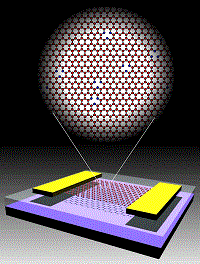Researchers from the University of Maryland have developed a method to control the magnetic properties of the material graphene, a method that could lead to important new applications in magnetic storage and memory.

Researchers from the University of Maryland have developed a method to control the magnetic properties of the material graphene, a method that could lead to important new applications in magnetic storage and memory.
Graphene, a one-atom-thick honeycomb-like sheet of carbon atoms, is the basic component of graphite. This material is two hundred times stronger than steel and conducts electricity at room temperature better than any other known material. Scientists regard this material as having great potential, and even revolutionary, in nanotechnological applications. For the discovery of the preparation of this substance, the Nobel Prize in Physics for 2010 was awarded to three scientists.
In their research, the scientists from the University of Maryland discovered that missing atoms in graphene, called "voids", function as tiny magnets - they have a magnetic moment. Furthermore, these magnetic moments react with the electrons in the graphene, which carry an electric charge, and this reaction produces a significant increase in electrical resistance at low temperature, a phenomenon known as the "Kondo effect". The research findings were published in the scientific journal Nature Physics.
This result is normally associated with adding a tiny amount of atoms of a magnetic metal, such as iron or nickel, to a non-magnetic metal, such as gold or copper. The discovery of the Kondo result in graphene for the empty spaces was a surprise for two reasons, the researcher notes.
"First, we studied a system that contained only carbon atoms, without adding any normal magnetic impurities. Second, graphene has a low electron density, a characteristic that is expected to lead to the appearance of the Kondo effect only at extremely low temperatures," explains the researcher.
The researchers measured the characteristic temperature for obtaining the Kondo result in graphene with empty spaces and found that it is equal to -183.15 degrees Celsius, a temperature similar to that obtained for metals with high electron densities. Moreover, for graphene, the Kondo temperature can be adjusted by changing the electric voltage with an electric gate - a result that was not observed in metals. The researchers believe that these unusual properties, likely due to the fact that the electrons in graphene function as if they were massless, also make them react strongly with certain types of impurities, such as vacancies, to obtain a strong Kondo result at a relatively high temperature.
The lead researcher believes that if it is possible to organize the empty spaces in the right way, it is possible that the graphene will become ferromagnetic (ferromagnetism). "Individual magnetic moments may be coupled to each other following the Kondo effect, which will force them to line up in the same direction," adds the researcher. "The result will be a ferromagnetic material, similar to iron, composed of carbon atoms only. The magnetism of graphene, if indeed accepted, could lead to the development of innovative types of detectors for the presence of magnetic fields. In addition, the combination of the unique electrical properties of graphene and its magnetism, could lead to the development of interesting applications in the field of spintronics, which utilizes the magnetic moment of the electron, instead of its electrical charge, in order to represent information in a computer. "Our research gives rise to the possibility of "defect engineering" in graphene - that is, controlled removal of atoms from the appropriate points in graphene in order to obtain the magnetic properties we desire," the lead researcher points out.
The news about the study

One response
The link to the news is not working...